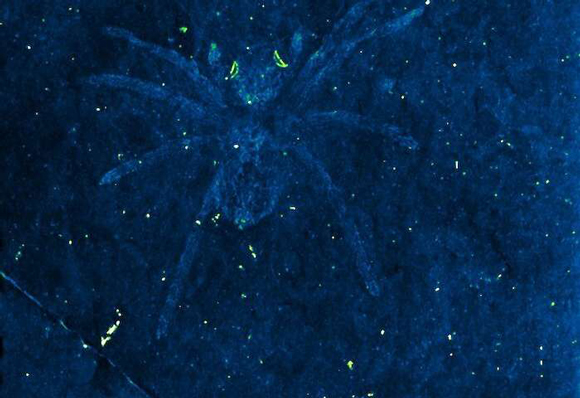Early Cretaceous Spiders Reveal Reflective Eyes
A team of scientists, including a researcher from the University of Kansas, writing in an academic journal (Journal of Systematic Palaeontology), have described spiders from the Early Cretaceous that had reflective eyes, an adaptation to permit these tiny predators to hunt at night. The remarkable Early Cretaceous spider fossils were discovered in black shale beds from South Korea. These beds form part of the Jinju Formation (Albian faunal stage) and the flattened fossils preserve the remains of spiders that lived between 113 and 110 million years ago.
The Light Reflective Properties of the Crescent-shaped Tapetum
Picture credit: Paul Selden/University of Kansas
Early Cretaceous Spider Fossils
Two of the fossils from the extinct spider family Lagonomegopidae feature reflective eyes. The fossils represent the first non-amber Lagonomegopidae to be described, with the first preservation of a spider eye tapetum recorded in the fossil record.
Co-author of the scientific paper, Paul Selden, Gulf-Hedberg Distinguished Professor of Geology and the Director of the Palaeontological Institute at Kansas University’s Biodiversity Institute and Natural History Museum, explained:
“Because these spiders were preserved in strange slivery flecks on dark rock, what was immediately obvious was their rather large eyes brightly marked with crescentic features. I realised this must have been the tapetum — that’s a reflective structure in an inverted eye where light comes in and is reverted back into retina cells. This is unlike a straightforward eye where light goes through and doesn’t have a reflective characteristic.”
Describing the Tapetum
Selden said that some contemporary spiders feature eyes with a tapetum, but the new paper is the first to describe the anatomical feature in a fossilised spider. The research team said the discovery provides evidence for lagonomegopid enlarged eyes being posterior medians.
“In spiders, the ones you see with really big eyes are jumping spiders, but their eyes are regular eyes — whereas wolf spiders at night time, you see their eyes reflected in light like cats. So, night-hunting predators tend to use this different kind of eye. This was the first time a tapetum had been in found in fossil. This tapetum was canoe-shaped — it looks a bit like a Canadian canoe. That will help us place this group of spiders among other families.”
Selden’s collaborators were Tae-Yoon Park of the Korea Polar Research Institute and amateur fossil hunter Kye-Soo Nam of the Daejeon Science High School for the Gifted, who found the fossils preserved in the shale.
Early Cretaceous Spiders from the Jinju Formation
The description of the fossils increases the number of known spiders from the Jinju Formation from a single specimen to eleven.
Commenting on their remarkable state of preservation, Paul added:
“This is so rare because they’re very soft — they don’t have hard shells so they very easily decay. It has to be a very special situation where they were washed into a body of water. Normally, they’d float. But here, they sank, and that kept them away from decaying bacteria, it may have been a low-oxygen condition. These rocks also are covered in little crustaceans and fish, so there maybe was some catastrophic event like an algal bloom that trapped them in a mucus mat and sunk them, but that’s conjecture. We don’t really know what caused this, but something killed off a lot of animals around the lake at one time or on an annual basis.”
According to Selden, the shale preserved the spider fossils in a manner that highlighted the reflectivity of the tapetum, a feature that may have been missed had the spiders been preserved in amber instead, as is more typical.
Preserved in the Black Shale an Almost Perfect Impression of an Early Cretaceous Spider
Picture credit: Paul Selden/University of Kansas
The discovery of these spiders will help researchers to piece together a better understanding of the environment that existed in South Korea during the Early Cretaceous.
Everything Dinosaur acknowledges the assistance of a press release from the University of Kansas in the compilation of this article.
Visit the customer-friendly Everything Dinosaur website: Everything Dinosaur.








Leave A Comment